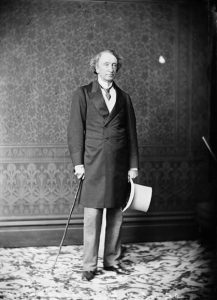Sir John A. Macdonald
1815-1891
Macdonald was Canada’s first prime minister, serving from 1867 to 1873 and from 1878 to 1891. The Conservative governments he led expanded Confederation by admitting three new provinces (Manitoba, British Columbia and Prince Edward Island), purchasing Rupert’s Land and promoting construction of the Canadian Pacific Railway.
Macdonald lived at three addresses in Sandy Hill. The first was 63 Daly Ave., a house that burned down in 1873. Sir John lived there for five years (1865-1870). There were no sewers in Ottawa at that time and Macdonald often had reason to complain about the drains in his house. The stench in his ground floor study was such that it forced him to move his desk upstairs to escape it. It was at this time that Lady Macdonald complained that flies were so numerous indoors that they were holding “parliament on the kitchen tablecloths”. (Gwynn R, 2011).
Between 1871 and 1875, the Macdonald family (including Macdonald’s mother in law who died in 1875) lived at the northwest corner of Chapel and Besserer (194 Chapel) in a spacious red brick house (“The Caddy”) that has since been demolished. The property extended at the time to Rideau St. The family kept a garden plot and raised chickens.
After winning the 1878 election, the Macdonalds moved to Stadacona Hall at 395 Laurier Ave E., which they rented for five years[1]. At the time, Stadacona Hall was the last house on the street. This large house, which still stands, is now the home of the Brunei High Commission. The house was originally built for John Cameron, a lumber magnate, in 1871, apparently by James Mather, and its name evokes either Quebec City (where an Iroquoian village of that name had once stood) or the gentlemen’s club in Kingston where Macdonald was a member. The Macdonalds kept peacocks in Stadacona Hall’s large gardens .
Macdonald was a charming, witty, unpretentious individual who, perhaps because of his personal flaws, was easily approachable. Many anecdotes were told about him that reflected his quick, self-deprecating wit. In 1871, during treaty negotiations in Washington, he arrived early at a social event and was engaged in conversation by the wife of an American senator:
- I guess you are from Canada.
- Yes, ma’am.
- You’ve got a very smart man over there, the Honourable John A. Macdonald.
- Yes, ma’am, he is.
- But, I hear he is a regu’ar rascal.
- Yes, ma’am, he is a perfect rascal.
- But why do they keep such a man in power?
- Well, you see, they cannot get along without him.
- But how is that? They say he’s a real scalawag, and — Just then her husband, the Senator, stepped up and said: “My dear, let me introduce the Honourable John A. Macdonald’.
The lady’s feelings can be imagined. But Sir John put her at ease saying, ‘Now, don’t apologize. All you’ve said is perfectly true, and is well known at home,’ (Smith and McLeod, 1989)

He also had the ability to separate work from his domestic life and relax fully at home. The Macdonald household at the time included Sir John A.’s wife, Agnes, their daughter Mary and Agnes’s brother Hewitt Bernard (Macdonald’s deputy minister[2]). Macdonald was a doting father to his daughter who required special care because she was born hydrocephalic (she would never be able to stand, walk or feed herself).
The years he spent at Stadacona Hall marked Macdonald’s greatest achievements as prime minister, including implementation of the National Policy (which promoted domestic manufacturing through high tariffs) and substantial progress on the completion of a trans-Canada rail line.
It is important to remember that these were simpler times. Macdonald handled almost all his correspondence himself by hand. He had no security detail. He did not have to worry about round-the-clock news coverage. His Cabinet was smaller and the Parliamentary session much shorter.
Macdonald was still in relatively good health (he turned 63 in 1878 and would live another 13 years) but was starting to show signs of age. His wife, already deeply religious, puritanical and 20 years younger, grew more imperious with time and ruled social Ottawa with “a rod of iron”. Richard Gwyn writes that it was during this period that she labeled the minister of justice a “pervert” because he had changed religion n order to marry, and refused to invite the finance minister to social functions because he had married a divorcée[3]. Lady Macdonald, however, was still capable of having fun, having famously ridden the train part way through the Rockies on the cowcatcher to the consternation of her whole entourage.
Macdonald’s funeral in 1891 was held at St Alban’s Church (Daly and King Edward). He is buried in Kingston.
[1] Macdonald finished his life at Earnscliffe, now the residence of the British High Commissioner. It was the first house he owned in Ottawa. He had rented it briefly in 1870.
[2] Bernard had roomed with Macdonald before, when they lived at 63 Daly Ave.
[3] For the record, the divorcée in question, Adeline Foster, had been abandoned by her first husband (hence the divorce) and was second president of the Ontario Woman’s Christian Temperance Union between 1882 and 1888, a position that hardly suggests loose morals. The Fosters remained officially ostracized until 1893.
